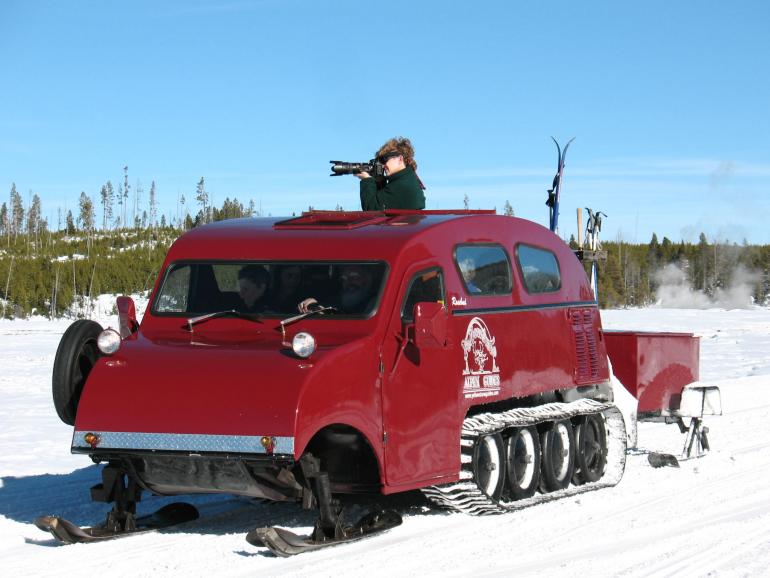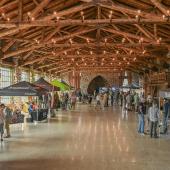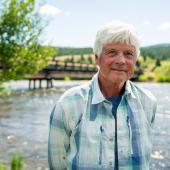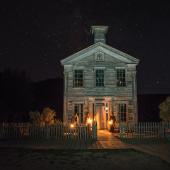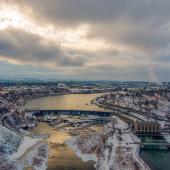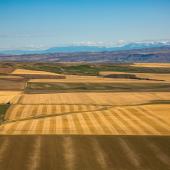From Snowmobile to Snowcoach
West Yellowstone rolls with the tide.
On a late October day in West Yellowstone, sun-drenched mountains and temperatures that creep into the sixties are convincing enough to lull any thoughts of bitter cold back into summer sleep. It is difficult to imagine that in a matter of weeks, the tourist town of one thousand will undergo a “snow” change, rediscovering its winter identity as a hotspot for outdoor enthusiasts. Yet the warm weather cannot steer Randy Roberson’s thoughts from the snow that is sure to fall in the coming months.
Roberson is the owner of Yellowstone Vacations, a West Yellowstone-based company that offers tours of the national park, among other visitor-oriented services. For years, he says, snowmobiles have dominated the town’s winter scene, and guided snowmobile tours into the park, such as those his business offers, have been the primary method to experience Yellowstone’s frozen glory. Indeed, West Yellowstone has frequently been dubbed the “snowmobile capital of the world.” The town’s location offers access to 600 miles of groomed trails, 200 inside Yellowstone National Park and 400 outside, and snowmobile sales and rental shops litter its grid-patterned streets. In late winter the town will host the 2nd annual Artic Cat Snow Blast (March 5-9) and the World Snowmobile Expo 2006 (March 16-19).
Roberson, however, sees a different winter-weather vehicle emerging as the town’s most recognizable mode of transport: the snowcoach. Until recently, the number of guided snowmobile trips into Yellowstone have dwarfed that of snowcoach tours, but now, he says, they are practically even. “Snowcoaches,” he claims, are “the best new way to see the park.”
For those not hip to Yellowstone’s fastest-growing trend, snowcoaches are enclosed vehicles equipped with caterpillar treads that offer visitors a comfortable and convenient method of experiencing the winter wonders of America’s first national park. They’re climate-controlled and can operate in all weather conditions. Roberson’s fleet comprises six coaches that can accommodate anywhere from six to 32 passengers and ferry guided tours from the start of winter until the Park closes to over-the-snow vehicles on March 12th.
Roberson cites two prominent reasons for the recent snowcoach boom. First, he claims, snowcoach tours are inherently less restrictive than guided snowmobile trips. At anytime during a tour, interested passengers can ask their guides questions or request a stop to take pictures. Entire families are able to board the same snowcoach and interact with each other as they explore the park. Secondly, snowcoach tours are cheaper than their snowmobile counterparts—a guided snowmobile tour can run upwards of $200 per person, while one can experience a snowcoach tour for less than $100. Also, snowcoach passengers need not worry about booking a tour months in advance, only to have inclement weather ruin their plans, as is often the case with snowmobile trips.
The recent growth in snowcoaches has been accompanied by a decline in snowmobiles in and around West Yellowstone. In November of last year, the National Park Service limited the amount of snowmobiles entering the park to 720 each day, all led by commercial guides and possessing four-stroke engines. Significant controversy has surrounded this issue, and it is easy to attribute snowcoach popularity to snowmobile restrictions and to envision the sleek vehicles filling with disgruntled snowmobilers.
Roberson claims that the opposite is true. “People are switching to snowcoach by choice,” he marvels. As someone who offers both snowcoach and snowmobile tours, Roberson is in a unique position to evaluate the recent trend. He points out that West Yellowstone’s claim to snowmobiling capital has by no means expired—just to the east of the town, for example, lies hundreds of miles of pristine trails. He also notes that the decrease in snowmobiles inside the park—the National Park Service averaged only 209 permits per day last winter out of the available 720—is due more to tourists’ confusion than inaccessibility, an opinion echoed by Ken Takata of Yellowstone Adventures, a snowmobile-rental business in town. Takata suggests that potential renters learn of the limit placed on snowmobiles and associate it with the Park being closed altogether to their vehicle of choice. Taking a snowmobile into Yellowstone, Takata says, has never been easier, as the regulations have frightened many away, and the newer four-stroke snowmobiles are more user-friendly.
Roberson believes that whether visitors choose to tour Yellowstone by snowmobile or snowcoach, their priority is to see the Park, not to support their favorite method of transportation. Yellowstone has so much to offer, he says, “that I still learn something new each time I take a tour.” He reassures winter sightseers that “there is no problem with either type of access to Yellowstone.”
Undoubtedly, winter in West Yellowstone will continue to be identified with snowmobiles, but lately the snowcoach has emerged as another mainstay of the town’s snow-season economy. Laurie Brunton, owner of Uncle Laurie’s Riverside Café, knows why: she has heard only positive comments on the new tours from patrons at her coffee and sandwich shop. “People have commented on how wonderful and smooth the rides are,” she reports. And because of the friendly confines and relatively low cost of snowcoach trips, guided tours of America’s first national park are more available, especially to “younger people and families.” That’s reason enough for anyone’s thoughts to drift towards winter on a warm October afternoon.
Winter Events in West Yellowstone
December
15Christmas Stroll
17SPAM Cup #1 Classic Race (XC Skiing)
21West Entrance to Yellowstone Opens to Over-the-Snow Travel
January
7SPAM Cup #2 Freestyle Race (XC Skiing)
February
25SPAM Cup #3 Classic Race (XC Skiing)
March
1127th Annual Yellowstone Rendezvous Marathon Ski Race
12West Yellowstone Youth Festival (XC Skiing)
13West Entrance to Yellowstone Closes to Motorized Travel until April 21
16-19World Snowmobile EXPO 2006
For more information, contact the West Yellowstone Chamber of Commerce at 406-646-7701 or visit www.westyellowstonechamber.com.

